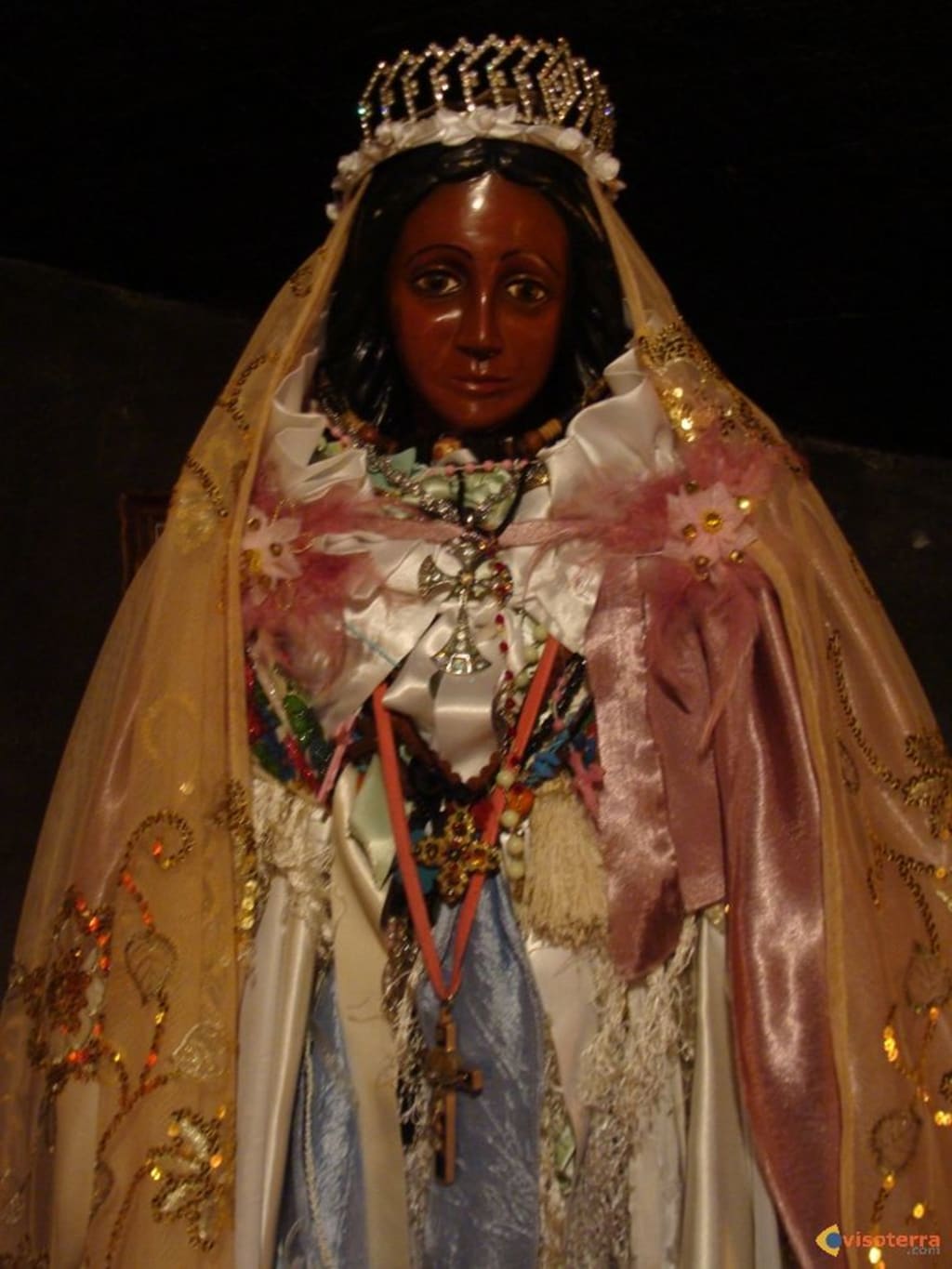Saint Sara la Kali
Patron Saint of the Gypsies

Once Jesus was crucified, we really don't hear anything more about his mother Mary or Mary Magdalene. As legend has it, a very concerted effort was made to destroy all of his followers.
Jesus was a major threat to Rome and its newfound religion which tied together church and government in a solid united front to basically rob the common people blind. That, in essence, other than the religious connotations was why Jesus was brutally crucified.
However, it would have been a little over the top for the church to crucify his innocent family, friends, and followers.
The legend continues that Mary Jacobe, sister of Mother Mary; Mary Salome, mother of apostles James and John; Lazarus, who was thought to have been raised from the dead and his sisters Martha and Mary Magdalene; Joseph of Arimethea, and other of Jesus's followers were cast out into the sea in a small boat without oars, sails, food, or water.
This is where Sara comes into the story. The most popular version is that Sara was the loyal servant of Mary Jacobe. As the little boat carrying her mistress floated out to sea, Sara became totally grief stricken. Mary Jacobe, seeing Sara so distraught and crying, cast her cloak upon the waves. Sara caught it and was pulled into the boat with the others.
Now, at this point, there are actually two different legends that both lead to how Sara became the patron saint of the Gypsies.
The first legend has it that Sara, with the help of an angel, guided the boat to Province, France. Both Marys and Sara stayed there, and this site eventually became known as Les Saintes. There they preached the gospel of Jesus, and the other members of the group spread throughout France.
The second legend, which is more popular with the Gypsies, is that Sara was already a tribal queen of the Camargue. When she heard about the arrival of the little boat, she welcomed the group of strangers with open arms and was baptised by them. She took them to her tribe at the temple of the sun, and the two Marys proceeded to convert the Gypsies to Christianity. This Pagan altar eventually became the first Christian shrine in France.
Sara, queen of the Gypsies, lived with the Marys until they died. When they died, she buried them and their burial site later became the church of Notre Dame de la Mer. Legend has it that the bones of both Marys are still there. Sara was also buried there. The bones of both Marys are in the upper chapel of the church where scenes of their lives are painted on their reliquary. But, since Sara is not a bona fide Christian Saint, her tomb is in the basement of the church where her Pagan altar once stood.
Every year on May 24, Gypsies arrive from all over the world in this little fishing town of Les Saintes-Maries-de-la-Mer to honor Sara as their Patron Saint. The next day is reserved in honor of Saints Mary Jacobe and Mary Salome.
The statue of Sara is brought up from her tomb and placed in the upper church. After paying tribute to the Marys, the Gypsies carry the statue of Sara to the sea for blessing. She is then returned to her tomb, where hundreds of Gypsies gather throughout the night, burning candles in her honor. Every year Sara is dressed in a new robe, which is placed over the robes of previous years. There is also a clothesline placed nearby which is filled with handkerchiefs, neckties, scarves, and socks from her faithful followers who seek her blessings. Photos, jewelry, and other objects are placed in a box nearby as thank you gifts for past favors granted and hope for new favors to be granted in the future.
Festivities continue into the next day with the images of the two Marys brought to the sea for blessings. Ceremonies follow complete with cowboys, ponies, and ceremonial garb.
Before they leave, many of the Gypsies stop at the well inside the church to gather water. This water is said to have miraculous healing abilities.
There is thought that there might also be a connection between the Hindu Goddess Kali Ma and Sara la Kali. In the language of the Romani, Kali Sara means Black Sara. In India, the Goddess Kali is known as Kali/Durga/Sara. Many Hindus and many Roma practice shaktism, which is the worship of Goddesses. And the Romani were once very much alive and well living in India.
So, it could be that Kali Ma, like some other Pagan Goddesses, has been remade into a Christianity acceptable saint.
I leave you with this Romani prayer to Sara.
"Sara, patron saint of travelers and gypsies the world over, you who lived in this region of Saintes-Maries-de-la-Mer. You came from a far-away country from across the seas. I love to come and find you here, to tell you all that I have in my heart and in you confide my sorrows and joys. I pray to you for everyone in my family and all my friends. Sara, come to me!" —Saint Sara-la-Kali: A Sister to Kali Ma.
About the Creator
Linda Paul
For as long as I can remember, I have wanted to be a writer. I tend to see life as a series of snapshots and magical moments. My six children are grown now, I am retired, and I would dearly love to pursue my love of the written word.






Comments
There are no comments for this story
Be the first to respond and start the conversation.